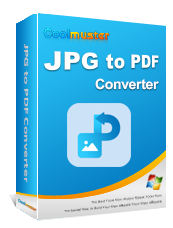
PNG vs PDF: Which Format Is Better for High-Quality Images?

In today's digital world, we often encounter a variety of file formats, with PNG and PDF being two of the most commonly used. Both formats have their own strengths, but when it comes to choosing between PNG vs PDF, it's important to understand the differences and benefits of each. Whether you're working with images or documents, knowing when to use PNG and when to opt for PDF can make a big difference in the quality and functionality of your files. In this article, we'll break down the key differences between PNG and PDF, helping you decide which format is best suited for your needs.
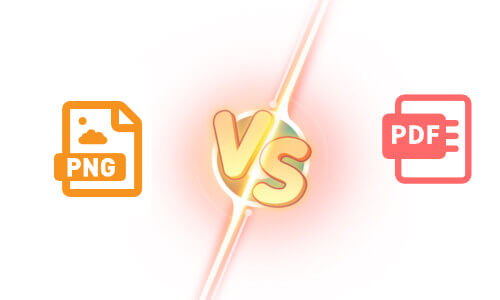
PNG (Portable Network Graphics) is an image format known for its lossless compression and high-quality output. Unlike JPEG, which uses lossy compression, PNG preserves the details of an image without any loss of quality. It's widely used for images that require transparency, such as logos, icons, and graphic design elements. PNG supports high-resolution images and is favored when clarity and quality are essential.
Key Features of PNG:
PDF (Portable Document Format), on the other hand, is a versatile format for documents that can contain text, images, hyperlinks, and even interactive elements. PDFs are commonly used for sharing files in a fixed format, ensuring that the content remains unchanged across different devices and platforms. Unlike PNG, which is purely an image format, PDF is a comprehensive document format that can contain more complex content.
Key Features of PDF:
The decision of whether to use PNG or PDF depends on the nature of your content and the intended use:
Graphics and logos: PNG's support for transparency and high-quality preservation makes it ideal for logos, icons, and web graphics.
Images requiring clarity: When you need to retain the sharpness and fine details of an image (such as infographics, charts, and detailed photos).
Transparent backgrounds: If your image requires a transparent background, PNG is your go-to option.
Document sharing: PDFs are best for sharing documents where layout and formatting must remain intact.
Printable materials: If you're preparing documents for printing, PDFs ensure consistent output across printers.
Multi-page content: PDFs are ideal for combining multiple pages into a single document, such as reports or e-books.
Let's break down the core differences between PNG and PDF in a simple comparison table:
| Feature | PNG | |
| File Type | Image format | Document format |
| Transparency Support | ✅ (Supports transparency) | ❌ (No transparency support) |
| Compression | Lossless compression | Can be lossless or lossy |
| Editing | Not easily editable | Editable (text, images, links) |
| File Size | Larger, high quality | Generally smaller, especially with text-heavy content |
| Common Uses | Logos, graphics, screenshots | Reports, contracts, e-books |
| Multi-Page Support | ❌ | ✅ (Multiple pages supported) |
| Best For | High-quality images | Fixed format documents |
If you've ever asked yourself, "Can I change a PNG file to PDF?", the answer is yes. Converting a PNG image to PDF is a simple process, and there are several methods available to help you do it quickly and efficiently. Whether you need to combine multiple PNG files into one PDF document or simply want to convert a single image for easy sharing, there are tools that can assist you in achieving this without compromising the quality of your images.
In this section, we'll show you the most straightforward way to convert PNG to PDF using reliable tools like Coolmuster JPG to PDF Converter. With just a few steps, you can create a high-quality PDF file from your PNG images, perfect for sharing or printing.
Key features of Coolmuster JPG to PDF Converter
How to convert PNG to PDF with Coolmuster JPG to PDF Converter?
01Start by visiting the Coolmuster official website to download and install the PNG to PDF converter. Please note that the software is currently compatible with Windows systems only.
02Open the software, and click the "Add File" button to upload the PNG images you wish to convert. You can choose to import a single image or multiple images at once.
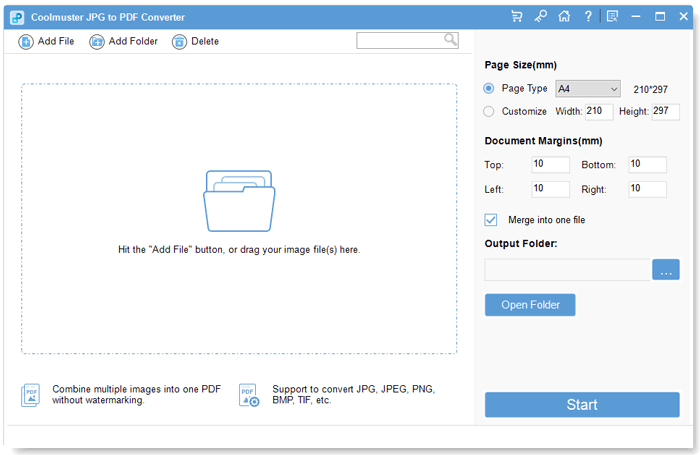
03Before you begin the conversion, customize the settings like page size, margins, and orientation to ensure the final PDF meets your preferences.
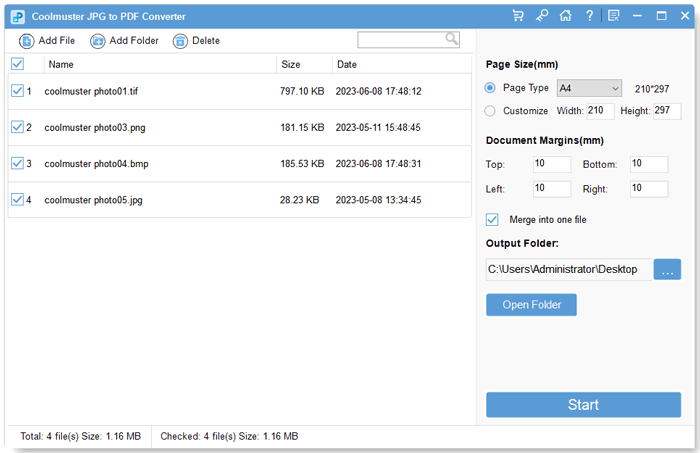
04Once you're satisfied with the settings, simply click the "Start" button. The software will quickly convert your PNG images into a PDF file, saving you both time and effort.
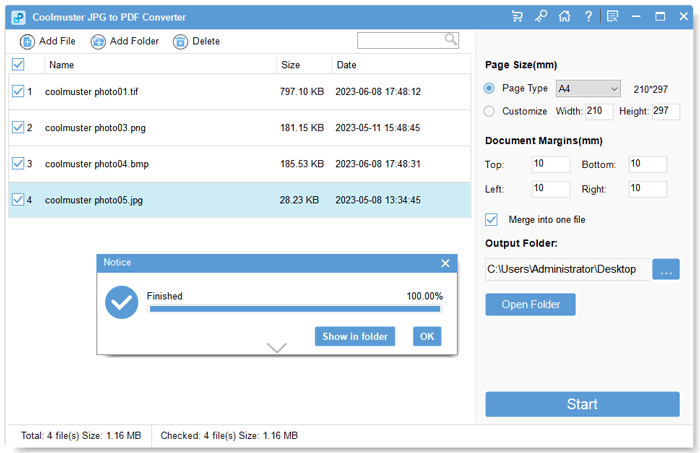
Video guide
1. Why should I convert PNG to PDF?
Converting PNG to PDF is useful when you need to combine images into a single document or preserve the quality and formatting of your image in a more universally accessible format. PDFs are also more suitable for printing and professional presentations.
2. Can I edit a PDF after converting PNG to PDF?
Yes, PDFs are editable, and you can modify the text, and images, or even add annotations. However, editing the image itself requires specific PDF editing software.
3. Will converting PNG to PDF affect the image quality?
No, converting PNG to PDF using reliable converters like Coolmuster JPG to PDF Converter retains the original quality of the image. The resolution, colors, and formatting of the PNG are preserved in the resulting PDF.
In conclusion, the decision between PNG and PDF depends on your specific needs. If you're dealing with high-quality images, graphics, or transparent backgrounds, PNG is the best option. However, if you need to share documents, ensure consistent printing, or combine multiple pages into one file, PDF is the superior choice.
For those looking to convert PNG images into PDF, Coolmuster JPG to PDF Converter offers a straightforward solution with no quality loss, ensuring your files are ready for easy sharing, printing, and storage.
Related Articles:
JPEG vs PDF: Understanding Differences & How to Convert JPG to PDF
[Full Guide] HEIC vs. PNG: Everything You Need to Know
How to Compress PNG Images? 8 Smart Strategies You Should Never Ignore
How to Convert PDF to PNG with High Quality? 8 Expert Tips and Tricks
